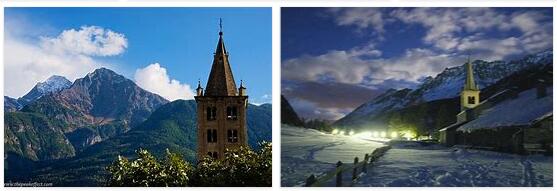Italy is a republic in Europe that is largely based on the dated Mediterranean Sea enclosed Apennine peninsula. The Alps rise up in the northern part of the country. Popular bathing areas on the Italian west coast include the Italian Riviera in Liguria and the Gulf of Naples in Campania. The Italian Adriatic runs on the east coast between northern Trieste and Garganoin Apullia. Here you will also find the most popular holiday beaches in Italy. The country also includes numerous islands, the largest being Sardinia and Sicily in the Mediterranean. Many of the smaller islands are also popular among travelers to Italy, for example the Egadi Islands, the Aeolian Islands, the Pontine Islands, the Tremti Islands or the islands of the Tuscan Archipelago. Italy also has an exclave in Switzerland.
The most important Italian rivers include the Po, the Arno, the Etsch and the Tiber (which flows through Rome, among others). The most famous lakes in Italy include Lake Como, Lake Garda and Lake Maggiore. By far the most important city in Italy is the capital Rome, other national centers include Milan, Genoa, Turin, Florence and Bologna in the north and Naples, Bari and Palermo in the south.
One of the most formative cultures in Europe developed on the Italian territory. Above all, the Greco-Roman influences in antiquity are still reflected in Europe today. The Roman Empire played a crucial role in the development of the music, art, and culture of many countries. European architecture was also often modeled on Roman models.
When the Byzantine Empire fell apart in the Middle Ages and the Renaissance, Italy benefited from the immigration of numerous scientists and scholars. Centers of sculpture and painting as well as science developed here. Artists like Botticelli, Raffael, Fra Angelico and Michelangelo and scientists like Leonardo da Vinci were formative for this epoch.
Italy – how to get there
Airplane: almost all European airlines offer flights to Italy. The biggest, Lufthansa,Air France and KLM, have offices in all major European cities. Italy’s national airline Alitalia offers a wide range of flight connections within Europe.
Inexpensive flights to Italy are on the flight schedule for Air Berlin, Air One, EasyJet, Clickair, Iberia, Meridiana, Ryanair, SAS, Sky Europe, SN Brussels Airlines, Spanair, Virgin Express and Vueling, among others.
Airports: Italy’s main airports are Leonardo da Vinci in Rome (FCO) and Malpensa in Milan (MXP). Inexpensive flights often land at regional airports, such as Ciampino in Rome (CIA), Galileo Galilei in Pisa and Marco Polo in Venice (VCE). Other important regional airports are Guglielmo Marconi in Bologna (BLQ), Elmas in Cagliari (CAG) in Sardinia, and Capodichino in Naples (NAP) and the Sicilian Airport of Palermo (PMO).
Ship: dozens of ferry companies connect Italy with almost every other Mediterranean country. However, many routes are only operated in summer. The prices for taking cars with you vary depending on the size of the vehicle. Eurail or Inter-Rail pass holders should inquire about discounts or free rides.
Some providers and connections:
Agoudimos Lines runs from Brindisi via Corfu to Igomenitsa, Blue Star Ferries from Brindisi and Acona to Patras and Igomenitsa. Endeavor Lines / Hellenic Mediterranean Lines bring passengers from Brindisi to Corfu, Igomenitsa, Patras and Cephalonia, from where ferries depart for Zakynthos.
Grandi Navi Veloci operates between Genoa and Barcelona, Grimaldi Ferries between Civitavecchia, Livorna, Salerno, Palermo and Tunisia as well as Barcelona.
Jadrolinija runs from Ancona to destinations along the Croatian coast, including Split and Zarda, and from Bari to Dubrovnik. Marmara Lines runs from Brindisi to Cesme, Turkey, Minoan Lines from Venice, Brindisi and Ancona to Igomenitsa, Corfu or Patras.
Skernderbeg Ferries connects Brindisi with the Albanian Vlore and Ventuouris Ferries runs from Bari via Corfu to Albanian Durrës, Virtu Ferries from Malta to Catania.
Rail: two routes connect Italy with the largest cities in Austria and Germany, France and Eastern Europe. The connection via the Brenner Pass leads to Innsbruck, Stuttgart and Munich with a branch in Tarvisio to Vienna, Salzburg and Prague. Trains from Milan go to Switzerland, France and the Netherlands. The main railway line to Slovenia crosses the border near Trieste.
In addition to Milan, there are international train connections to and from Rome, Venice, Genoa, Turin, Verona, Bologna, Florence and Naples. Detailed information and timetables are available from Tren Italia.
Car: the most important border crossings to Italy are the Mont Blanc tunnel from Chamonix in France, the Grand St. Bernard tunnel and the Gottard tunnel from Switzerland and the Brenner tunnel from Austria. Snow chains are necessary in winter and the passes are sometimes impassable.
If you travel to Italy with your own car, you need a valid driver’s license, a vehicle registration document, liability insurance and a sticker with the country’s registration number. Help and information is available from the Automobile Club Italiano (ACI). Roadside assistance is provided by the RAC and the Automobile Association (AA).
Buses from Eurolines, an association of European bus companies, go to Milan, Rome, Florence, Siena and Venice.
